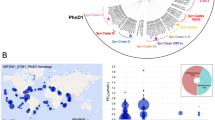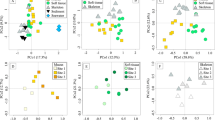Abstract
Phosphonates are characterized by a stable carbon–phosphorus bond and commonly occur as lipid conjugates in invertebrate cell membranes. Phosphonoacetate hydrolase encoded by the phnA gene, catalyses the cleavage of phosphonoacetate to acetate and phosphate. In this study, we demonstrate the unusually high phnA diversity in coral-associated bacteria. The holobiont of eight coral species tested positive when screened for phnA using degenerate primers. In two soft coral species, Sinularia and Discosoma, sequencing of the phnA gene showed 13 distinct groups on the basis of 90% sequence identity across 100% of the sequence. A total of 16 bacterial taxa capable of using phosphonoacetate as the sole carbon and phosphorus source were isolated; 8 of which had a phnA+ genotype. This study enhances our understanding of the wide taxonomic and environmental distribution of phnA, and highlights the importance of phosphonates in marine ecosystems.
Similar content being viewed by others
Log in or create a free account to read this content
Gain free access to this article, as well as selected content from this journal and more on nature.com
or
References
Benitez-Nelson CR, O'Neill L, Kolowith LC, Pellecia P, Thunell R . (2004). Phosphonates and particulate organic phosphorus cycling in an anoxic marine basin. Limnol Oceanogr 49: 1593–1604.
Dyhrman ST, Benitez-Nelson CR, Orchard ED, Haley ST, Pellechia PJ . (2009). A microbial source of phosphonates in oligotrophic marine systems. Nat Geosci 2: 696–699.
Dyhrman ST, Chappell PD, Haley ST, Moffett JW, Orchard ED, Waterbury JB et al. (2006). Phosphonate utilization by the globally important marine diazotroph Trichodesmium. Nature 439: 68–71.
Hilderbrand RL . (1983). The Role of Phosphonates in Living Systems. CRC Press: Florida, USA.
Gilbert J, Thomas S, Cooley NA, Kulakova AN, Field D, Booth T et al. (2009). Potential for phosphonoacetate utilization by marine bacteria in temperate coastal waters. Environ Microbiol 11: 111–125.
Ilikchyan IN, McKay RM, Zehr JP, Dyhrman ST, Bullerjahn GS . (2009). Detection and expression of the phosphonate transporter gene phnD in marine and freshwater picocyanobacteria. Environ Microbiol 11: 1314–1324.
Karl DM, Beversdorf L, Bjorman KM, Church MJ, Martinez A, DeLong EF . (2008). Aerobic production of methane in the sea. Nat Geosci 1: 473–478.
Kulakova AN, Kulakov LA, Quinn JP . (1997). Cloning of the phosphonoacetate hydrolase gene from Pseudomonas fluorescens 23F encoding a new type of carbon-phosphorus bond cleaving enzyme and its expression in Escherichia coli and Pseudomonas putida. Gene 195: 49–53.
Martinez A, Tyson GW, Delong EF . (2009). Widespread known and novel phosphonate utilization pathways in marine bacteria revealed by functional screening and metagenomic analyses. Environ Microbiol (e-pub ahead of print 29 September 2009).
Padayao DO, San Diego-McGlone ML . (2000). Nitrogen and phosphorus in coastal systems: focus on dissolved organic N and P. Sci Dilliman 12: 51–58.
Quinn JP, Kulakova AN, Cooley NA, McGrath JW . (2007). New ways to break an old bond: the bacterial carbon-phosphorus hydrolases and their role in biogeochemical phosphorus cycling. Environ Microbiol 9: 2392–2400.
Reshef L, Koren O, Loya Y, Zilber-Rosenberg I, Rosenberg E . (2006). The coral probiotic hypothesis. Environ Microbiol 8: 2068–2073.
Stillway LW, Harmon SJ . (1980). A procedure for detecting phosphonolipids on thin-layer chromatograms. J Lipid Res 21: 1141–1111.
Acknowledgements
This study was funded through the NERC studentship grant NE/F009534/1. All phnA and 16S rDNA sequences were submitted under the following: FJ177645–FJ177966.
Author information
Authors and Affiliations
Corresponding author
Additional information
Supplementary Information accompanies the paper on The ISME Journal website (http://www.nature.com/ismej)
Supplementary information
Rights and permissions
About this article
Cite this article
Thomas, S., Burdett, H., Temperton, B. et al. Evidence for phosphonate usage in the coral holobiont. ISME J 4, 459–461 (2010). https://doi.org/10.1038/ismej.2009.129
Received:
Revised:
Accepted:
Published:
Issue date:
DOI: https://doi.org/10.1038/ismej.2009.129
Keywords
This article is cited by
-
Global and seasonal variation of marine phosphonate metabolism
The ISME Journal (2022)
-
Trait-Based Comparison of Coral and Sponge Microbiomes
Scientific Reports (2020)
-
Marine actinobacteria associated with marine organisms and their potentials in producing pharmaceutical natural products
Applied Microbiology and Biotechnology (2014)
-
Organophosphonates revealed: new insights into the microbial metabolism of ancient molecules
Nature Reviews Microbiology (2013)
-
Phylogenetic Diversity of Actinobacteria Associated with Soft Coral Alcyonium gracllimum and Stony Coral Tubastraea coccinea in the East China Sea
Microbial Ecology (2013)



